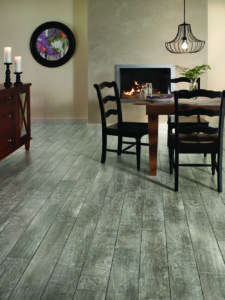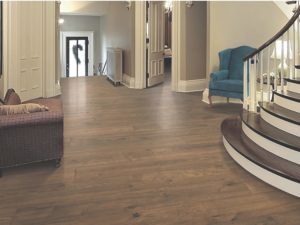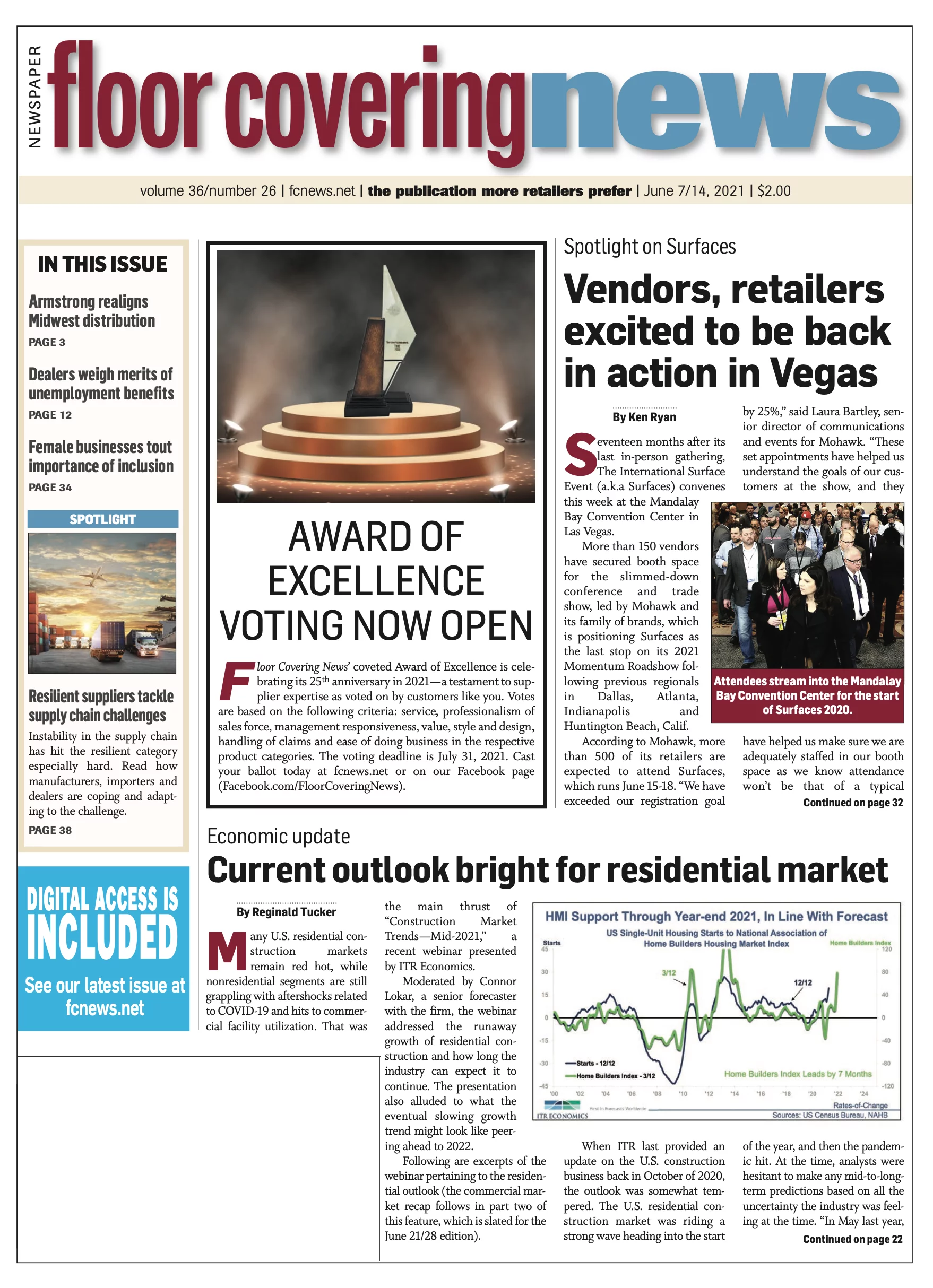By Reginald Tucker Ongoing supply chain issues at U.S. ports—as well as those around the world—have impacted virtually every business sector, flooring included. Nowhere is this more evident than in the resilient flooring category. But just as one man’s passion is another’s poison, the strained supply situation affecting shipments of SPC and LVT/P seems to be having a positive impact on laminate flooring—especially domestically made products.

At Independent Carpet One Floor & Home, Westland, Mich., the renewed interest in the laminate category is palpable. “The resurgence of laminate is great,” said Cathy Buchanan, co-owner and showroom manager. “It’s a more scratch-resistant, water-resistant product at a fabulous price to our customers.”
In particular, Buchanan cited increased sales of Mohawk- and Mannington-branded products. “Their visuals are amazing, and we trust them to provide a quality floor for our customers,” she said. “Our customers love the solid feeling underfoot and the quieter aspect that laminate provides in their home.”
Buchanan is not alone. Typhannie Watson, owner of Carpeting by Mike, Somerset, Wis., is also experiencing higher laminate sales of late. “Waterproof laminates are among the leaders in our stores.”
Even high-volume, upper-echelon retailers and groups such as the National Floorcovering Alliance (NFA) are seeing an uptick in laminate sales amid supply constraints related to alternative options. With some NFA retailers finding many rigid core SKUs out of stock and/or eight weeks from delivery, U.S.-made laminate products are making a comeback of sorts.
“We’re doing exceptionally well with laminate right now,” said David Chambers, director of flooring, Nebraska Furniture Mart. “For those retailers that gave up on that category when the big box stores wanted to take it over, shame on them. That’s a great little business.”
Deb DeGraaf, co-owner of DeGraaf Interiors, Grand Rapids, Mich., concurred. “We’re actually doing very well with laminates right now,” she told FCNews. “It’s more durable against scratching than LVP every day of the week. You tell it to somebody who has a dog running around the house and she says, ‘Oh, you better show me laminate then.’”
Some retailers are actually not surprised about the renewed focus on laminate vs. vinyl plank. For Art Simonyan, owner of Modern Hardwood Floors, Los Angeles, it’s the category’s proven track record that continues to generate sales. “Even if you put it over a subfloor that has some imperfections, it will still perform very well,” he said, citing the Republic Floor brand he carries. “The quality of the laminate products today are very good, it looks like hardwood and the installation is not complicated. Consumers are usually very happy after we install laminate in their homes.”
Advancements boost appeal

While laminate flooring has long been touted for its waterproof or water-resistant capabilities, only recently have retailers emphasized these attributes as an alternative to resilient flooring options. From its inception in Europe in the early 1990s to its debut in the North American market later that same decade, laminate flooring provided a durable, tough hard surface flooring option for consumers looking for alternatives to more costly options such as hardwood, tile and stone. But thanks to ongoing innovations, suppliers have been able to leverage new technologies designed to: increase the product’s resistance to moisture; expand its overall thickness to resemble that of real wood; and render more realistic visuals that reflect the demands of today’s consumers.
“Moisture-resistant and waterproof laminates will continue to lead the charge in this category,” said Dan Natkin, vice president of hardwood and laminates, Mannington. “They combine the best attributes of laminate (long-term wear performance) with the moisture resistance of vinyl.”
For Mannington, it’s not just talk. The company has invested significantly in its laminate manufacturing operations to further enhance the capabilities of its product offerings. The outcome of that R&D resulted in SpillShield Plus, an update on its water-resistant technology developed for laminate. The new-and-improved SpillShield Plus protection entails treating the bevels and the locking joints to fight water incursion from common mishaps such as spills and accidents as opposed to catastrophic water line breaks that can flood the floor.
For those manufacturers who continued to invest in the laminate flooring category when others retracted, the gamble is paying off. After the launch of its RevWood program several years ago, Mohawk continues to build upon the popular line via new iterations. “We had quite a few expansions of the RevWood Plus and Select category over the past couple of years, and we continued that this year as well,” said Adam Ward, senior product director, wood and laminate. “We’ll continue to support the category with new launches to stay in front of our customers. It’s all about keeping the momentum going.”
CFL Flooring, maker of the popular Atroguard waterproof laminate flooring line, is also counting on technology to get retailers excited about laminate flooring again. “Laminate flooring provides RSAs with both a performance and design story,” said Barron Frith, president of the company’s North American operations. “Water-resistant laminate’s main advantages from a performance standpoint are still scratch and stain resistance.”
Another factor playing to laminate suppliers’ advantage is a broader move toward more environmentally friendly and low-VOC flooring products. That, coupled with advances in digital printing technology, makes for a compelling proposition. “The continued improvement of laminate looks and textures along with exploiting laminate’s environmental/sustainability story resonates with the emerging millennial market,” Frith stated.
Laminate suppliers say the application of innovative technologies will only continue to drive the category forward, despite the market share WPC and SPC flooring products have seized in recent years.

